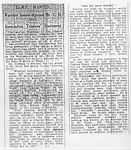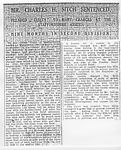 Warrant - County Express 4.3.1933
Warrant - County Express 4.3.1933 Trial - County Express 1.7.1933
Trial - County Express 1.7.1933 Report of Counsel's appeal on behalf of Charles Sitch - 1.7.1933
Report of Counsel's appeal on behalf of Charles Sitch - 1.7.1933

Charles Sitch's public life ended in 1933. He was arrested and pleaded guilty to using the funds of the Chainmakers' and Strikers' Association (C.M.S.A.) for his own purposes. He was sentenced to nine months in prison. When he was released he left Cradley Heath. What led a man like him, who had spent thirty years helping others, and who had the respect of all who knew him, to commit such a crime?
The newspaper cuttings shown here tell the story of his arrest and trial. The Trustees of the C.M.S.A first became suspicious, when they had to delay the annual general meeting, because Charles was missing. A warrant was issued, and a search began. On the 4th March he gave himself up. He was committed for trial at the Staffordshire Assizes.
The trial took place in July 1933. Charles pleaded guilty to stealing over £4,569 of the C.M.S.A.'s funds. He had done so over a period from 1928 to 1932. He also pleaded guilty to falsifying entries in the cash book, so that there appeared to be more money in the deposit account than there really was. In order to be fair to Mr. Sitch, the prosecution pointed out, that payments to members of sickness benefit, funeral expenses and so on were in order.
The third newspaper cutting has a full report of the appeal, made by Charles' counsel. Local people and organisations expected a lot from him, and in the end he was living beyond his means.
Charles' sentence reflected the good work he had done over the years. He was sentenced to nine months in the "second division." This meant that he was allowed some privileges and creature comforts.
Many people still thought of Charles as a hero. Some even believed that he had been "set up" . Others believed him to be a scoundrel. Oral histories collected by the Museum suggest that Charles was not alone in the deception, and that what really upset people was less the crime, and more the fact that his imprisonment meant his parliamentary seat was lost to a Tory. Unfortunately, we have been unable to throw more light on the matter, because the documents passed on to the Museum with the Institute building in 2004 are incomplete. It is alleged that all the paperwork relating to the period prior to the 1930s was burned.
After leaving prison, Charles lived in Jersey for a while, and then moved to Leeds, where he worked for Reynolds Newspaper, in a position of trust, for the next fifteen years. He retired in 1952, and died in 1960.
Rollover the captions in the box to see the available images in thumbnail format, click the caption to see the full-size image
| Reference: | 661 |
| Keywords: | |
| Archive Ref: | |
| Updated: | Tue 17 Jul 2007 - 1 |
| Interpretation written by | Barbara Harris |
| Author's organisation | |
| Organisation's website |